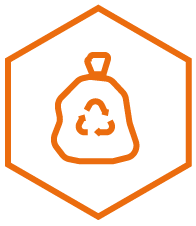Fuels
Hydrogen
Hydrogen is extremely versatile, and can be transformed into electricity, used as a fuel for transportation and has many various other industrial applications. It is also the most abundant and lightest element in the universe and has the highest energy content of all common fuels by weight.
The vast majority of industrial hydrogen produced today is produced from steam methane reformation (SMR) which breaks apart natural gas to release hydrogen, creating significant greenhouse gas emissions. The second most popular production method is electrolysis which electrically breaks water molecules into their principal elements (H2 and O) but requires both a lot of electricity and clean water.
Raven SR turns biomass, municipal solid waste, bio-solids, industrial, sewer and medical waste, and methane into emissions-free, 99.999% pure, clean hydrogen through our patented Steam/CO2 Reforming process.
The Raven SR system offers the best overall economic and environmental benefits for waste generators and processors, while also offering the most favorable economics. Our technology eliminates negative environmental impacts associated with other types of hydrogen production, while also offering an environmentally sustainable alternative to the incineration and landfilling of waste.

Hydrogen that is 99.999% pure

Producing clean hydrogen from waste destined for landfill or incineration

The most favorable economics of any steam reforming system processing biomass into fuels

Raven SR hydrogen to be sold at local fueling stations
Synthetic Fuels
Synthetic fuels are more pure carbon chains, purposely created with specific number of hydrogens and carbons (CnH(2n+2)) and exclude sulfur. Rather than extracted from existing hydrocarbons – they are put together, as opposed to taken apart.
To create synthetic fuels, Raven SR first converts the feedstock – biomass, municipal solid waste, bio-solids, industrial waste, sewage, medical waste and methane – into synthetic gas. The synthetic gas produced by Raven SR has a much higher hydrogen content than competing technologies, meaning that we can produce higher volumes of both hydrogen and synthetic fuel from our feedstock. Raven’s syngas prior to additional polishing is already at 2:1 ratio of hydrogen and carbon-monoxide needed for Fischer-Tropsch reactors.
Essentially, Raven SR can process anything containing hydrogens and carbons.
Once we have produced the synthetic gas, it is then converted into synthetic diesel and synthetic aviation fuels including Jet A, Jet B and milspec JP-8 using the Fischer-Tropsch process.
Fischer-Tropsch synthetic fuels have higher purity and burn more cleanly than traditional hydrocarbon fuels. They also have higher energy content per carbon content of the fuel, and Fischer-Tropsch jet fuel is less dense than conventional fuel allowing aircraft to fly further on the same load of fuel.

Better quality, higher engine output and greater torque

Better flowability, lower freeze point and higher viscosity

Higher purity and burns more cleanly than traditional hydrocarbon fuels

High cetane numbers, a near-zero sulfur content and very low aromatic levels
Raven SR advantage

Less electricity
Uses less per kilogram of hydrogen than other electrolysis, plasma gasification and microwave plasma.

Uses no water
Uses no fresh water unlike electrolysis, and processes waste wet as naturally found in landfills without drying.

Creates fewer process emissions
Because Raven SR is non-combustion, dangerous emissions (NOx, SOx, PMs, etc.) are avoided.

Divert waste
Keeps waste out of landfills and reduces greenhouse emissions that come from decomposing organic waste.